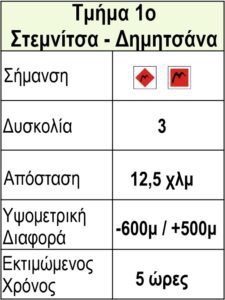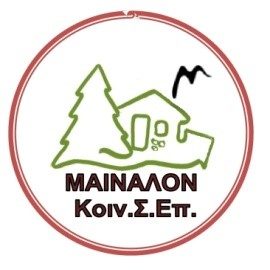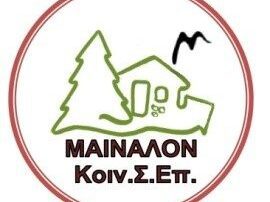Section 1: Stemnitsa-Dimitsana
The trail head for this first route is Stemnitsa, the village of goldsmiths and headquarters for the Peloponnesians Senate in 1821, point of convergence of many other routes and trails. Follow the coming out of the village and heading towards the Prodromos Monastery. Start from the main square of the village next to the church belfry. Take the dirt road that winds the slopes below the paved road. Just before St. Nikolaos,a sign post directs you to the first path, the old mule track to the Prodromos Monastery.
On your left there are great panoramic views of Megalopoli. This footpath is well designed and some parts of it are paved, it crosses an old farmland area that used to be an important winemaking region and its centre was the Kamari fountain. Upon intersecting the asphalt road, follow it for a while, until reaching the church of the Transfiguration of Christ where you can take water from the fountains and rest while admiring the view of the Lousios gorge before going into the paved path that leads to the Prodromos Monastery.
Notice the boulder where the monastery is nested right above you (open every day, closes at noon, there is a fountain in the courtyard) and soon encounter the path that traverses the gorge. Following you’ll reach Dimitsana. Cross the river using the concrete Philosophou Bridge, at the place where the riverbed narrows impressively. Ascend to the Old Philosophou Monastery dating to 963 and then to the New Philosophou Monastery who was founded in a less restricting place in 1691. After a short break, take the old mule track starting from the parking lot heading to Dimitsana. The traverse of the western bank of the ravine, above land lots and old farmhouses will lead us the Monopori Bridge. With the help of the bridge the footpath changes bank, passes the Tzani Bridge and ascends bringing you close to Paliochori, bypass it heading towards the Open Air Water Power Museum. Even though you can go across the museum’s open perimeter, the sign posts go round it heading towards the big headwaters at Agios Ioannis, the sources that make the array of watermills, gun mills and fulling mill turn, the very mills that made the fame and wealth of Dimitsana, or the historic continuation of the Homeric Teuthis. From here the path follows a combination of roads to arrive to Dimitsana, but enters in glory through a very well preserved paved road that emerges right in the heart of the settlement, the saddle between its two big neighbourhoods, and therefore the commercial core of this small town.
The route is well waymarked with and . On every junction there are orientation signposts.














